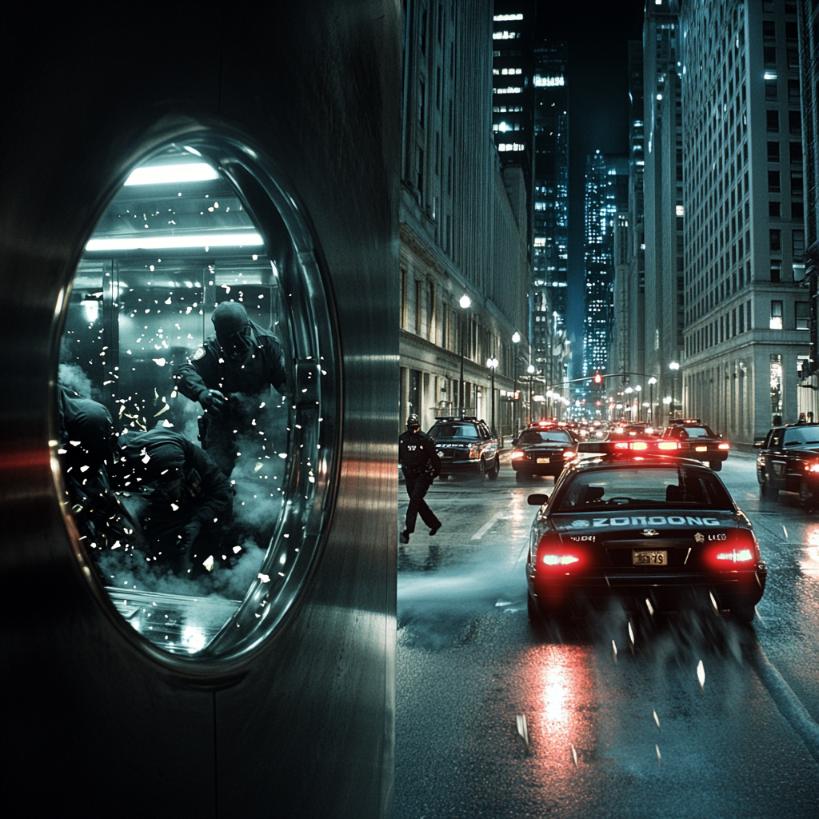Cross-Cutting in Movies: Mastering A Film Editing Technique
Introduction
Cross-cutting in movies is a powerful film editing technique that plays a crucial role in the way stories are told on screen. At its core, cross-cutting involves alternating between two or more scenes that are happening simultaneously but in different locations. This method not only helps to build tension and suspense but also allows filmmakers to create a dynamic narrative flow that keeps the audience engaged.
The significance of cross-cutting in film editing cannot be overstated. It’s a technique that has been used by filmmakers for over a century to enhance storytelling by showing the connection between parallel events. Whether it’s to build up to a climactic moment or to juxtapose different storylines, cross-cutting is essential for creating a more complex and layered narrative.
Mastering the art of cross-cutting is vital for anyone involved in film production. When done correctly, it can dramatically improve the pacing of a film, emphasize thematic elements, and deepen the audience’s emotional investment in the story. Understanding how to effectively use cross-cutting not only elevates your editing skills but also opens up new possibilities for innovative and impactful storytelling in your films.
What is Cross-Cutting in Movies?
Cross-cutting is a film editing technique where the editor alternates between two or more different scenes happening simultaneously in separate locations. This method allows filmmakers to weave together multiple storylines, creating a sense of urgency, suspense, or thematic connection. By cutting back and forth between these scenes, the audience perceives that the events are occurring at the same time, even though they are unfolding in different places.
Historically, cross-cutting has played a significant role in the evolution of cinematic storytelling. One of the earliest and most influential uses of cross-cutting can be traced back to D.W. Griffith’s 1915 film, The Birth of a Nation. Griffith used cross-cutting to heighten tension by showing parallel events, such as a rescue sequence where one group rushes to save another just in time. This technique not only added dramatic tension but also revolutionized the way stories were told on screen, allowing for more complex and layered narratives.
It’s important to distinguish between cross-cutting and parallel editing, as the two are often confused. While both techniques involve alternating between different scenes, their purposes differ. Cross-cutting focuses on creating the illusion that events are happening simultaneously, often to build suspense or draw connections between different narrative threads. Parallel editing, on the other hand, also involves cutting between different scenes, but it may not necessarily imply that the events are occurring at the same time. Parallel editing is often used to compare and contrast different storylines or themes, or to explore the relationships between different events in a more abstract way.

The Purpose of Cross-Cutting in Movies
Cross-cutting is an invaluable tool in film editing, serving multiple purposes that enhance the overall storytelling experience. One of its primary functions is to build and sustain narrative tension. By alternating between different scenes that occur simultaneously, cross-cutting creates a sense of urgency and anticipation. The audience is drawn into the unfolding action, eagerly awaiting the resolution of each scene, which heightens the emotional impact of the narrative.
In terms of pacing, cross-cutting allows filmmakers to control the rhythm of the story. By cutting between parallel events, editors can quicken the pace during intense moments or slow it down to build suspense. This dynamic pacing keeps the audience engaged, ensuring that the film maintains momentum and doesn’t drag. For instance, in action sequences or climactic moments, cross-cutting can create a fast-paced, adrenaline-pumping experience by showing multiple threads of the story converging simultaneously.
Another significant purpose of cross-cutting is its ability to create connections between different storylines or events happening at the same time. This technique can juxtapose characters’ actions, drawing thematic parallels or contrasts that enrich the narrative. It allows the filmmaker to explore multiple perspectives and story arcs within the same timeframe, offering a more complex and layered understanding of the story. For example, cross-cutting might be used to show the simultaneous struggles of two characters in different locations, thereby highlighting their shared experiences or fate.
Several iconic movies have effectively utilized cross-cutting to enhance their storytelling. One of the most famous examples is The Godfather (1972), directed by Francis Ford Coppola. In the film’s climactic baptism scene, Coppola uses cross-cutting to juxtapose the peaceful ritual of a baby’s baptism with the violent murders ordered by Michael Corleone. This contrast not only heightens the tension but also underscores the theme of duality within Michael’s character—his outward appearance of legitimacy versus his ruthless actions.
Another exemplary use of cross-cutting can be found in Christopher Nolan’s Inception (2010). The film intricately weaves multiple layers of dreams, each operating at different levels of consciousness. Nolan uses cross-cutting to switch between these dream layers, creating a complex narrative structure that builds tension as the characters’ actions in one layer directly affect events in another. The technique effectively conveys the film’s central concept of interconnected realities, keeping the audience invested in the outcome of each parallel storyline.
How to Implement Cross-Cutting in Film Editing
Implementing cross-cutting in film editing requires careful planning, a clear understanding of your narrative structure, and attention to detail during the editing process. Below is a step-by-step guide to help you plan and execute cross-cutting effectively, along with tips for smooth transitions and maintaining narrative clarity, and common mistakes to avoid.
Step-by-Step Guide to Planning and Executing Cross-Cutting
Identify Parallel Scenes
- Begin by identifying the scenes in your script that will benefit from cross-cutting. These are typically scenes that happen simultaneously or are thematically linked. Ensure that these scenes have a narrative connection that justifies the use of cross-cutting.
Storyboard the Sequence
- Before editing, create a storyboard or a visual outline of the scenes you plan to cross-cut. This helps in visualizing how the scenes will interweave and ensures that the pacing and transitions will flow smoothly. Pay attention to the emotional beats of each scene and how they will impact the overall narrative.
Shoot with Cross-Cutting in Mind
- When filming, consider the needs of cross-cutting in your shots. Capture a variety of angles and perspectives that will allow for flexibility in the editing room. Ensure that the visual and thematic elements in the scenes are strong enough to create a connection when intercutting.
Assemble Rough Cuts
- In the editing software, start by assembling rough cuts of each scene individually. Once you have the individual scenes laid out, begin to intercut them, paying close attention to how the transitions feel. Experiment with different points to cut between scenes to find the most effective moments for building tension or drawing parallels.
Fine-Tune the Timing
- Timing is crucial in cross-cutting. Fine-tune the cuts to ensure that the pacing feels natural and that the transitions between scenes enhance the narrative flow. Use the rhythm of the dialogue, action, or music to guide your cuts. The timing should build suspense or create a smooth narrative transition without confusing the audience.
Tips for Smooth Transitions and Maintaining Narrative Clarity
Use Visual or Thematic Cues
- To ensure smooth transitions between scenes, use visual or thematic cues that link the scenes together. This could be a recurring object, a sound, or a similar action that appears in both scenes, helping the audience understand the connection.
Maintain Consistent Pacing
- While cross-cutting can vary in pace, it’s important to maintain consistency so that the audience isn’t jarred by abrupt changes. Gradually build up the tension or pace as the scenes progress, leading to a climax that ties the intercut scenes together effectively.
Focus on Clarity
- Always prioritize clarity in your narrative. Make sure that the audience understands what is happening in each scene and why the scenes are being intercut. Avoid over-complicating the sequence with too many cuts, which can lead to confusion.
Common Mistakes to Avoid When Using Cross-Cutting
Overusing Cross-Cutting
- Cross-cutting is a powerful tool, but it can lose its impact if overused. Avoid the temptation to cross-cut too frequently, as this can disrupt the flow of the narrative and reduce the tension you’re trying to build. Reserve cross-cutting for key moments in the film where it will have the most dramatic effect.
Neglecting Narrative Cohesion
- One of the biggest mistakes in cross-cutting is failing to maintain narrative cohesion. If the scenes you are intercutting don’t have a strong narrative or thematic link, the cross-cutting will feel disjointed and confuse the audience. Always ensure that the scenes are connected in a meaningful way.
Ignoring Emotional Beats
- Cross-cutting should enhance the emotional impact of a film, not detract from it. Be careful not to cut away from a scene too quickly, especially during critical emotional moments. Allow the audience to fully engage with each scene’s emotional beat before moving to the next.
Benefits of Using Cross-Cutting in Movies

Cross-cutting is a versatile and powerful film editing technique that offers numerous benefits, significantly enhancing the storytelling experience. By skillfully implementing cross-cutting, filmmakers can achieve increased viewer engagement, heightened emotional impact, and a distinctive style and tone for their films. Below, we explore these advantages in detail.
Increased Viewer Engagement
One of the most significant benefits of cross-cutting is its ability to keep viewers engaged throughout the film. By alternating between different scenes or storylines, cross-cutting creates a dynamic flow that captures the audience’s attention. This technique introduces a sense of anticipation and curiosity, as viewers become invested in how the parallel scenes will converge or resolve. The back-and-forth nature of cross-cutting keeps the narrative moving at a brisk pace, preventing stagnation and maintaining the audience’s interest.
In fast-paced sequences, cross-cutting can intensify the action by showing multiple events happening simultaneously, often leading to a climactic moment. This technique effectively draws the audience into the unfolding drama, making them feel like they are part of the action. As a result, viewers are more likely to stay engaged, eager to see how the interconnected events will play out.
Enhanced Emotional Impact
Cross-cutting also plays a crucial role in enhancing the emotional impact of a film. By juxtaposing different scenes, filmmakers can create powerful contrasts that amplify the emotional resonance of the story. For example, cross-cutting between a moment of joy in one scene and a moment of tragedy in another can evoke a deep emotional response from the audience. This technique allows for a more nuanced exploration of the characters’ experiences and the themes of the film, making the story more emotionally compelling.
Furthermore, cross-cutting can be used to build tension and suspense by gradually revealing parallel events that lead to a dramatic payoff. As the audience becomes aware of the impending consequences of each scene, their emotional investment in the story intensifies. This buildup can lead to moments of catharsis or shock, leaving a lasting impression on the viewer.
Contribution to a Film’s Overall Style and Tone
Beyond its narrative and emotional benefits, cross-cutting can significantly contribute to a film’s overall style and tone. The way cross-cutting is employed can define the rhythm and mood of a movie, whether it’s a fast-paced thriller or a slow-burning drama. For instance, rapid cross-cutting between intense scenes can create a sense of urgency and chaos, suitable for action films or psychological thrillers. Conversely, more measured cross-cutting between reflective scenes can establish a contemplative or somber tone, ideal for dramas or art-house films.
Moreover, cross-cutting allows filmmakers to explore thematic connections between different storylines, adding depth to the film’s narrative structure. By drawing parallels or contrasts through cross-cutting, directors can subtly convey themes and motifs that might not be as apparent through traditional linear storytelling. This technique can help to craft a more sophisticated and layered narrative, contributing to the film’s artistic identity.
Conclusion
Cross-cutting in movies is a powerful editing technique that has been instrumental in shaping the way stories are told on screen. By seamlessly alternating between parallel scenes, cross-cutting enhances narrative tension, keeps viewers engaged, and amplifies the emotional impact of a film. It allows filmmakers to explore complex, layered stories and create a distinctive style and tone that resonates with audiences.
As you continue to develop your skills in film editing, don’t hesitate to experiment with cross-cutting in your projects. Whether you’re aiming to build suspense, draw thematic connections, or simply add a dynamic flow to your narrative, cross-cutting offers endless possibilities for creative storytelling.
To dive deeper into the world of film editing and discover more techniques that can elevate your work, explore the resources available on Mosaico Productions. We offer a wealth of insights and tips to help you refine your craft and bring your cinematic vision to life.

